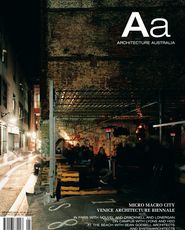PHOTOGRAPHY Dianna Snape
Peter Skinner reviews Homo Faber, an exhibition of architectural working models at the Melbourne Museum, and its accompanying symposium.
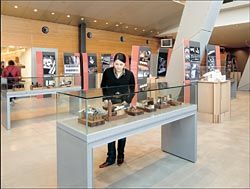
An overview of the Homo Faber exhibition with Peter Downton’s models in the foreground.
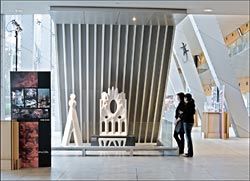
Overview including Mark Burry’s models from Antoni Gaudi’s Sagrada Familia, Barcelona.
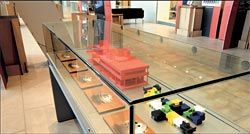
“Thought experiment” studies of Le Corbusier’s Villa Savoye by Ostwald, Tucker and Chapman.
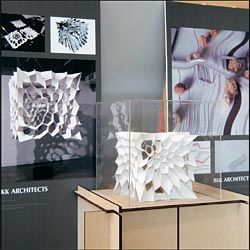
BKK Architects’ “Bucky-box”.
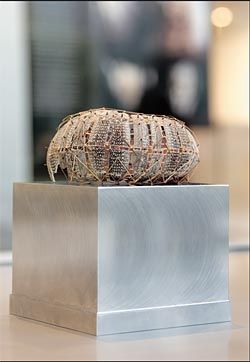
One of Andrea Mina’s beautifully crafted miniature models.
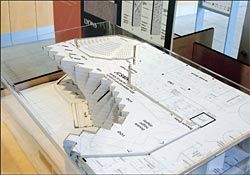
Working model of the John Curtin Medical Research Centre at the Australian Capital University by Lyons.
For reasons I can’t explain to the teaching and learning committee, my first lecture to new architecture students usually begins with a screening of Charles and Ray Eames’ 1977 film, Powers of Ten. Surprisingly un-creaky analogue effects zoom us out from “a picnic by the lakeside in Chicago” to “the outer edges of the universe”, before penetrating biological, molecular and atomic scales to the flickering uncertainty at the heart of matter. The film captivates; together we hold infinity in a projector beam and eternity in nine minutes ten.
The excitable horde at the opening of the Homo Faber: modelling architecture exhibition at the Melbourne Museum in May seemed similarly captivated by the essences of architecture on display.
Miniature outputs from major firms were laid head-to-head, generating partisan frissons that were overlaid with a more vicariously shared pleasure. Those who had not actually held the exhibited artefacts in their own hands had all at some time fashioned, photographed or fondled very close relatives of these models.
The exhibition, symposium and accompanying publication, 115 pages shrunk to minidisc, are the impressive output from the first year of a major Australian Research Council Discovery Grant project. Conducted by Professor Mark Burry, Professor Peter Downton and Associate Professor Andrea Mina of RMIT University and Newcastle University’s Professor Michael Ostwald, the investigation will run over three years.
It probes the role of physical and digital modelling in twenty-two leading Australian practices through interviews and the study of their modelled output, including the pieces shown in the Homo Faber exhibition.
The investigators’ credentials were also clearly on show. Mark Burry’s formidable contribution to the realization of Antoni Gaudi’s masterwork is well known and generously supported here by sponsorships from Spain and the church that enabled the inclusion of major models, and the participation of the venerable Jordi Bonet, Sagrada Familia’s Architect Director.
Burry’s insights into design conceptualization from his Gaudi work and from his experimental teaching and research at SIAL set an enquiring and receptive tone for the subsequent symposium. Michael Ostwald presented thought experiment models that were as technically challenging in their manifestation as they were conceptually intriguing. He laid a solid scholarly foundation for the project in his exhaustive essays. Peter Downton’s patient, personal engagement with design was presented as beautifully crafted models and equally considered commentary. The thumb-sized miniatures by Andrea Mina were, for me, the most powerful objects in the room.
Minute models testing the structural integrity of organic materials, the limits of bodily stillness and the steadiness of optical and conceptual focus, their microcosmic carapaces held Piranesian interiors worthy of pin-dancing angels.
Design research is a hunt for an elusive quarry – that defining moment when a design becomes an idea that can be held in the head. Quite reasonably, the search for the grail has led to the model that can be held in the hand. In Homo Faber the academic truth-hounds are sniffing excitedly at process models – quick, preferably spontaneous card and balsa constructions that might represent a key point at which crucial design conceptions are manifested in miniature, comprehended, critiqued and communicated. Homo Faber contains a few sweetly humble but potent ephemera, the twist of a paper, or the fold of a card, that can be held retrospectively to be the embodiment of a key gesture within a design. Others, such as BKK’s beguiling “Bucky-box”, have an immediacy in the gallery, though minute scorch marks reveal a much more circuitous laser-led trajectory from mind to matter.
The symposium was an engaging and open academic exchange, charting the conceptual terrain and testing taxonomies – are miniatures, maquettes, mock-ups, mechanisms, and mementos models?
… models of? … or models for? … mmm.
Architecture, of course, involves more than a moment of insight, and in the office, designs pass through many hands and many minds in an evolutionary process of articulation, critique and adaptation.
Physical models are rarely executed by the named design architect, more often by colleagues and assistants as tokens of in-house communication. Working models, “dog models” as some call them, may start life as physical representations of verbal, sketched or signalled communication, and through iterative generations may evolve into novel bitsers or robust mongrels, or through careful strains characteristics of pedigree may be enhanced. In subsequent protocol studies by the team, it would be interesting to hear from the real Homos Faber as well – those who groom the dog models between shows.PETER SKINNER IS ASSOCIATE PROFESSOR OF ARCHITECTURE AT THE UNIVERSITY OF QUEENSLAND.

